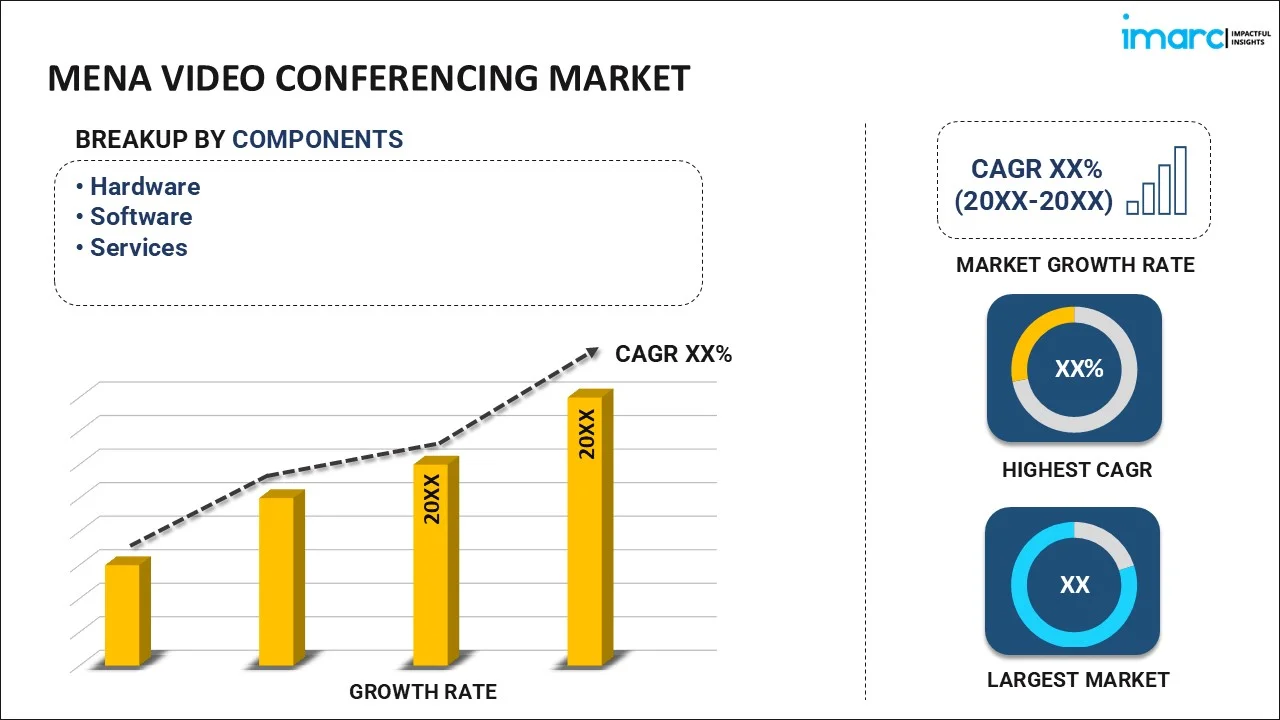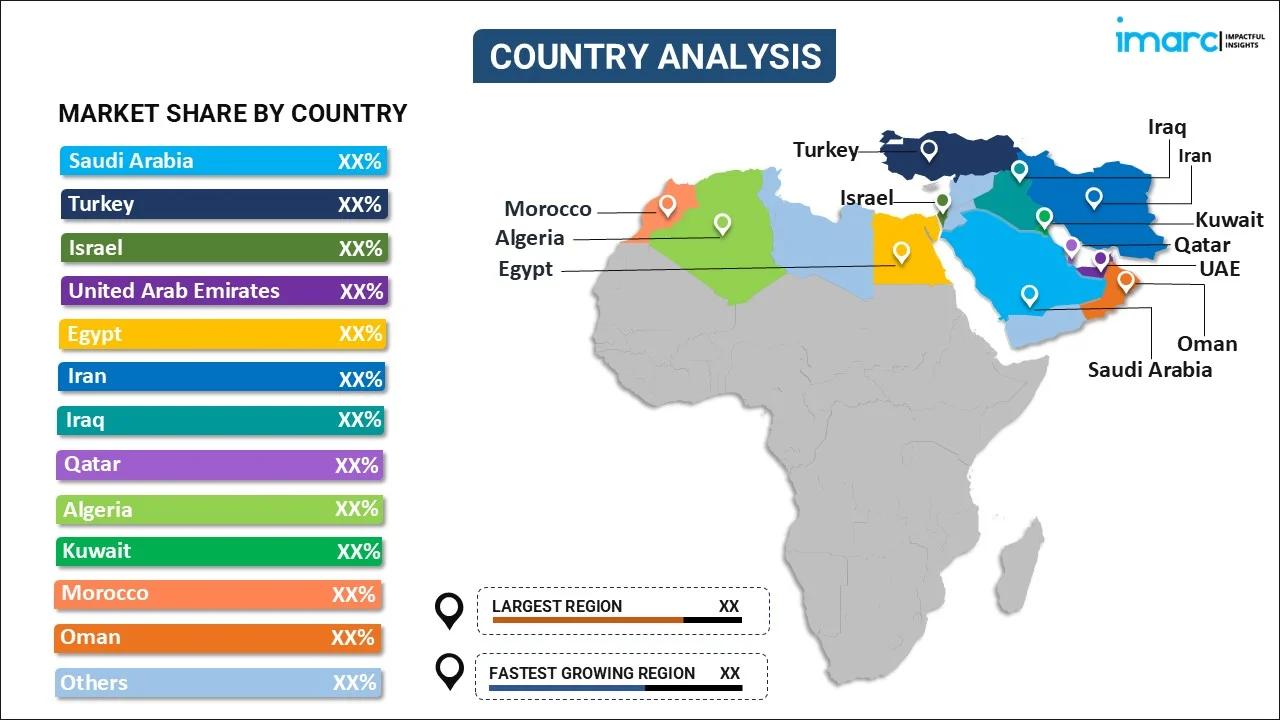
MENA Video Conferencing Market Report by Component (Hardware, Software, Services), Deployment (On-premises, Cloud), Industry Vertical (Corporate, Government and Defense, Healthcare, Education, BFSI, Media and Entertainment, and Others), and Region 2025-2033
Market Overview:
The MENA video conferencing market size reached USD 380.2 Million in 2024. Looking forward, IMARC Group expects the market to reach USD 3,851.5 Million by 2033, exhibiting a growth rate (CAGR) of 27.87% during 2025-2033. The growing need for flexible and efficient communication tools among business organizations, increasing popularity of telemedicine and remote healthcare consultations, and rising adoption of online solutions due to rapid digitalization represent some of the key factors driving the market.
|
Report Attribute
|
Key Statistics
|
|---|---|
|
Base Year
|
2024 |
|
Forecast Years
|
2025-2033
|
|
Historical Years
|
2019-2024
|
| Market Size in 2024 | USD 380.2 Million |
| Market Forecast in 2033 | USD 3,851.5 Million |
| Market Growth Rate (2025-2033) | 27.87% |
Video conferencing is a technological solution that enables seamless virtual communication and collaboration among businesses and individuals. It allows participants to connect in real time through audio and video channels. It offers enhanced flexibility and convenience and reduces the limitations posed by physical distances. It also provides a comprehensive set of features, such as screen sharing, file sharing, and interactive presentations, which makes it a valuable tool for businesses seeking to enhance productivity, streamline operations, and maintain effective communication. It is cost-effective as it reduces travel and operational expenses and saves time by allowing participants to join from anywhere. It enables real-time editing and sharing of documents that benefit in decision-making. It assists in providing an enhanced communication experience as compared to audio-only methods. It also offers encryption and authentication measures to protect sensitive conversations and data during meetings. Besides this, it is beneficial in improving work-life balance for employees, as they can attend meetings and events without disrupting their personal lives. As a result, the demand for video conferencing solutions is rising in the MENA region.
MENA Video Conferencing Market Trends:
At present, the increasing need for flexible and efficient communication tools among individuals represents one of the major factors influencing the market positively in the MENA region. Moreover, the rising adoption of online solutions due to rapid digitalization, along with the increasing utilization of smart devices, such as laptops, smartphones, and computers among individuals, is strengthening the growth of the market. Apart from this, the growing demand for reliable video conferencing solutions to facilitate remote collaboration is offering a positive market outlook. Additionally, the rising adoption of cost-effective online meeting solutions among small and medium-sized enterprises (SMEs) is providing lucrative growth opportunities to industry investors in the region. In line with this, the integration of artificial intelligence (AI) and machine learning (ML) technologies in video conferencing to enhance the user experience by enabling features such as automatic transcription and real-time language translation, is impelling the market growth. Besides this, governing agencies in the MENA region are undertaking several initiatives for digital infrastructure development. In addition, the increasing adoption of video conferencing in the education industry for remote learning and enhanced student experience is bolstering the growth of the market in the region. Furthermore, the increasing popularity of telemedicine and remote healthcare consultations to reduce the need for in-person visits is contributing to the growth of the market in the MENA region.
MENA Video Conferencing Market Segmentation:
IMARC Group provides an analysis of the key trends in each segment of the MENA video conferencing market report, along with forecasts at the regional and country levels for 2025-2033. Our report has categorized the market based on component, deployment, and industry vertical.
Component Insights:

- Hardware
- Software
- Services
The report has provided a detailed breakup and analysis of the market based on the component. This includes hardware, software, and services.
Deployment Insights:
- On-premises
- Cloud
A detailed breakup and analysis of the market based on the deployment has also been provided in the report. This includes on-premises and cloud.
Industry Vertical Insights:
- Corporate
- Government and Defense
- Healthcare
- Education
- BFSI
- Media and Entertainment
- Others
A detailed breakup and analysis of the market based on the industry vertical has also been provided in the report. This includes corporate, government and defense, healthcare, education, BFSI, media and entertainment, and others.
Country Insights:

- Saudi Arabia
- Turkey
- Israel
- United Arab Emirates
- Egypt
- Iran
- Iraq
- Qatar
- Algeria
- Kuwait
- Morocco
- Oman
- Others
The report has also provided a comprehensive analysis of all the major regional markets, which include Saudi Arabia, Turkey, Israel, United Arab Emirates, Egypt, Iran, Iraq, Qatar, Algeria, Kuwait, Morocco, Oman, and Others.
Competitive Landscape:
The report has also provided a comprehensive analysis of the competitive landscape in the market. Competitive analysis such as market structure, key player positioning, top winning strategies, competitive dashboard, and company evaluation quadrant has been covered in the report. Also, detailed profiles of all major companies have been provided.
MENA Video Conferencing Market Report Coverage:
| Features | Details |
|---|---|
| Base Year of the Analysis | 2024 |
| Historical Period | 2019-2024 |
| Forecast Period | 2025-2033 |
| Units | Million USD |
| Scope of the Report | Exploration of Historical and Forecast Trends, Industry Catalysts and Challenges, Segment-Wise Historical and Predictive Market Assessment:
|
| Components Covered | Hardware, Software, Services |
| Deployments Covered | On-premises, Cloud |
| Industry Verticals Covered | Corporate, Government and Defense, Healthcare, Education, BFSI, Media and Entertainment, Others |
| Countries Covered | Saudi Arabia, Turkey, Israel, United Arab Emirates, Egypt, Iran, Iraq, Qatar, Algeria, Kuwait, Morocco, Oman, Others |
| Customization Scope | 10% Free Customization |
| Post-Sale Analyst Support | 10-12 Weeks |
| Delivery Format | PDF and Excel through Email (We can also provide the editable version of the report in PPT/Word format on special request) |
Key Questions Answered in This Report:
- How has the MENA video conferencing market performed so far and how will it perform in the coming years?
- What is the breakup of the MENA video conferencing market on the basis of component?
- What is the breakup of the MENA video conferencing market on the basis of deployment?
- What is the breakup of the MENA video conferencing market on the basis of industry vertical?
- What are the various stages in the value chain of the MENA video conferencing market?
- What are the key driving factors and challenges in the MENA video conferencing market?
- What is the structure of the MENA video conferencing market and who are the key players?
- What is the degree of competition in the MENA video conferencing market?
Key Benefits for Stakeholders:
- IMARC’s report offers a comprehensive quantitative analysis of various market segments, historical and current market trends, market forecasts, and dynamics of the MENA video conferencing market from 2019-2033.
- The research study provides the latest information on the market drivers, challenges, and opportunities in the MENA video conferencing market.
- Porter's five forces analysis assist stakeholders in assessing the impact of new entrants, competitive rivalry, supplier power, buyer power, and the threat of substitution. It helps stakeholders to analyze the level of competition within the MENA video conferencing industry and its attractiveness.
- Competitive landscape allows stakeholders to understand their competitive environment and provides an insight into the current positions of key players in the market.
Need more help?
- Speak to our experienced analysts for insights on the current market scenarios.
- Include additional segments and countries to customize the report as per your requirement.
- Gain an unparalleled competitive advantage in your domain by understanding how to utilize the report and positively impacting your operations and revenue.
- For further assistance, please connect with our analysts.
 Request Customization
Request Customization
 Speak to an Analyst
Speak to an Analyst
 Request Brochure
Request Brochure
 Inquire Before Buying
Inquire Before Buying




.webp)




.webp)












